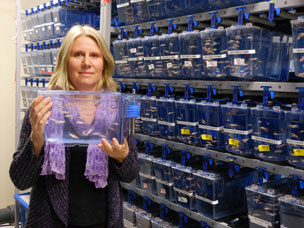Zebrafish ‘Became Chubby’ and Had Higher BMI Upon Being Exposed to Compounds
 Could your electronics be making you fat? According to University of Houston researchers,
a common flame retardant used to keep electronics from overheating may be to blame.
Could your electronics be making you fat? According to University of Houston researchers,
a common flame retardant used to keep electronics from overheating may be to blame.
Scientists at UH’s Center for Nuclear Receptors and Cell Signaling (CNRCS) have been researching the issue using zebrafish. Supported by a $375,209 grant from the National Institutes of Health’s National Institute for Environmental Health Sciences (NIEHS), the researchers set out to screen for compounds that lead to obesity, called obesogens.
They studied the effect of two common flame retardants on sibling zebrafish and found the fish that were exposed to the compounds became heavier and longer, compared to their untreated siblings in the control group.
These flame retardants – tetrabromobisphenol A (TBBPA) and tetrachlorobisphenol A (TCBPA) – are used to keep electronics from overheating and are found in computers, cell phones, televisions, tablets, video game consoles and other high-tech devices with electrical chips that could catch fire if they get overheated. These compounds are then released from such electronics and often end up in the dust we inhale.
A type of the much-maligned bisphenol A (BPA), which is already known to be an obesogen, these flame retardants are highly produced compounds. About 150,000 tons of TBBPA and 10,000 tons of TCBPA are produced per year.
“It’s been shown that young children, who spend a lot of time on the floor, have higher levels of these compounds in their blood than adults. It has also been found to be passed through breast milk,” said Maria Bondesson, a research assistant professor of biology and biochemistry with the CNRCS. “This is what led us to exposing the fish siblings to these compounds at relatively low concentrations. The fish treated with these compounds became heavier and the ones that weren’t were lighter.”
The researchers treated the zebrafish with these suspected obesogens for eleven days and fed them a diet of egg yolks as their source of fat. They then stained the fish for lipids, or fat cells. Despite both fish being fed a high-cholesterol diet, the normal fish didn’t accumulate lipids in their bodies like the treated fish did. This helped the research team isolate that it was indeed the obesogens and not the diet causing the fish to gain weight.
 “The transparency of the zebrafish allowed us to see where the increased amounts of
fat cells were. There was an enormous difference between the treated fish and their
siblings in the control group,” Bondesson said. “We could see the lipids accumulated
in the liver, the heart region, the head and very obviously in the blood vessels.
We also could see it subcutaneously along the side of the fish.”
“The transparency of the zebrafish allowed us to see where the increased amounts of
fat cells were. There was an enormous difference between the treated fish and their
siblings in the control group,” Bondesson said. “We could see the lipids accumulated
in the liver, the heart region, the head and very obviously in the blood vessels.
We also could see it subcutaneously along the side of the fish.”
After the initial 11 days of exposure to these flame retardants, the fish stopped being treated with the suspected obesogens. After one month being kept under equal and normal conditions, the fish that had been exposed to the flame retardants were heavier and longer than their siblings. Additionally, they were more heavy than long, so their BMI was higher, too.
The mechanism at the root of all this is a hormone receptor called PPARgamma, which has the propensity to turn stem cells into adipocytes, more commonly known as fat cells. It is known from previous studies that flame retardants such as TBBPA and TCBPA can activate this receptor. Bondesson, together with Professor Jan-Åke Gustafsson and their team, hypothesized that these flame retardants, then, would serve as a trigger for fat cells to form and, therefore, might work as obesogens. Her group was the first to test this in a living organism.
“Given the growing obesity epidemic and the serious health conditions it often leads to, our research shows that it’s important to study if chemicals are obesogens,” Bondesson said. “Our goal is to find the worst ones and then replace them with safer alternatives.”
Working with Bondesson and Gustafsson on this study were fellow CNRCS researchers Catherine McCollum, Anne Riu and Caroline Pinto, in collaboration with researchers from France.
Bondesson recently attended an NIEHS-hosted Institute of Medicine workshop on environmental exposures leading to obesity March 2-3 in North Carolina. Scientific presentations explored the role of chemical exposures in the development of obesity.
- Lisa Merkl, University Media Relations